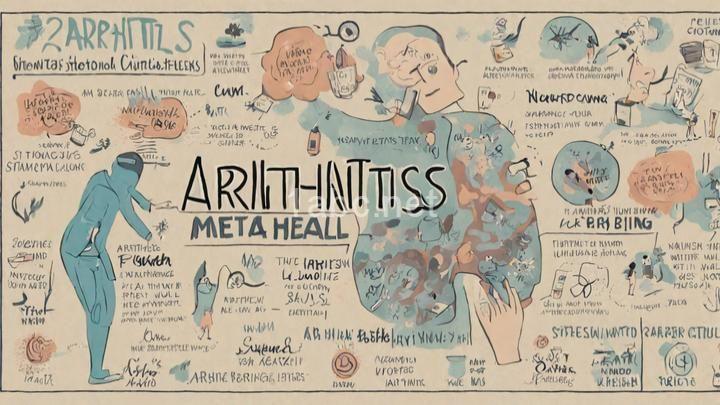The Role of Physical Therapy in Arthritis Pain Management

Introduction:
Arthritis is a debilitating condition that affects millions of individuals worldwide. It causes pain, stiffness, and inflammation in the joints, making even simple tasks a challenge. In this blog post, we will explore the role of physical therapy in managing arthritis pain and improving the quality of life for those living with this condition.
Section 1: Understanding Arthritis Pain
Arthritis comes in several forms, with the most common types being osteoarthritis and rheumatoid arthritis. Osteoarthritis is a degenerative condition that occurs when the protective cartilage in the joints wears down over time. Rheumatoid arthritis, on the other hand, is an autoimmune disease where the body's immune system mistakenly attacks the joints.
The symptoms of arthritis can vary from person to person. Common signs include joint pain, stiffness, swelling, and a reduced range of motion. Arthritis pain can be localized to specific joints or affect multiple joints throughout the body. The intensity of the pain can also range from mild discomfort to excruciating agony.
Living with arthritis pain can be challenging. Individuals often struggle to perform daily activities such as walking, climbing stairs, or even getting out of bed. The constant pain and stiffness can significantly impact their quality of life, making it essential to find effective pain management strategies.
Section 2: The Benefits of Physical Therapy
Physical therapy is a non-invasive and drug-free treatment option that has shown great promise in managing arthritis pain. It focuses on relieving pain, improving mobility, and enhancing overall function. By addressing the underlying issues causing pain and stiffness, physical therapy aims to restore individuals' ability to move comfortably and perform daily activities.
One of the key benefits of physical therapy is its ability to help individuals regain strength, flexibility, and range of motion. Arthritis can weaken the muscles surrounding the affected joints, leading to further pain and instability. Physical therapy exercises target these muscles, strengthening them and providing stability to the joints.
Additionally, physical therapy can help reduce inflammation in the joints. Inflammation is a significant contributor to arthritis pain and can be alleviated through various therapeutic modalities used in physical therapy.
Section 3: Types of Physical Therapy for Arthritis Pain Management
Physical therapy encompasses a range of techniques and modalities to address arthritis pain. Some of the commonly used modalities include heat/cold therapy, electrical stimulation, and ultrasound. Heat therapy helps relax muscles and increase blood circulation, while cold therapy reduces inflammation and numbs the affected area. Electrical stimulation and ultrasound can also provide pain relief and promote healing.
Therapeutic exercises are a fundamental aspect of physical therapy for arthritis pain management. These exercises are tailored to address specific joint issues caused by arthritis. They focus on improving flexibility, strength, and range of motion in the affected joints. Physical therapists may recommend exercises such as stretching, low-impact aerobic activities, and resistance training to help individuals manage their arthritis pain effectively.
In addition to modalities and exercises, manual therapies are often utilized in physical therapy for arthritis pain relief. Joint mobilization techniques help improve joint function and reduce pain. Massage therapy can also be beneficial in relieving muscle tension and promoting relaxation.
Section 4: Working with a Physical Therapist
Finding a qualified physical therapist specializing in arthritis pain management is crucial for effective treatment. It is essential to choose a therapist who understands the unique challenges individuals with arthritis face and can tailor the treatment plan accordingly.
Open communication with the physical therapist is key to personalized care. Individuals should feel comfortable discussing their symptoms, concerns, and goals. By actively participating in their treatment plan, individuals can ensure that their needs are being addressed and progress is being made.
During physical therapy sessions, individuals should not hesitate to ask questions or seek clarification. The therapist is there to guide and support them throughout their journey to pain relief. By having a clear understanding of the exercises and techniques being used, individuals can continue their therapy at home and enhance their progress.
Section 5: Lifestyle Modifications for Long-Term Pain Relief
Physical therapy is most effective when combined with lifestyle modifications that promote long-term pain relief. Weight management plays a significant role in arthritis pain management, as excess weight puts additional strain on the joints. Maintaining a healthy weight through proper nutrition and regular exercise can help reduce pain and improve overall joint health.
Gentle exercise routines, such as swimming or yoga, can complement physical therapy by promoting joint flexibility and muscle strength. These activities are low-impact and easier on the joints, making them ideal for individuals with arthritis.
Proper nutrition and hydration are also essential in managing arthritis pain. A diet rich in anti-inflammatory foods, such as fruits, vegetables, whole grains, and omega-3 fatty acids, can help reduce inflammation in the joints. Staying hydrated ensures that the body can effectively flush out toxins and maintain joint health.
Incorporating relaxation techniques into everyday life can also be beneficial for managing stress-related flare-ups. Techniques such as deep breathing, meditation, and mindfulness can help individuals cope with the emotional and physical toll of living with arthritis.
Conclusion:
Physical therapy plays a crucial role in managing arthritis pain and improving the quality of life for those living with this condition. By addressing pain, improving mobility, and enhancing overall function, physical therapy offers an effective and non-invasive treatment option.
It is essential for individuals with arthritis to consult with a healthcare professional or physical therapist to explore their options for pain relief. Taking an active role in their treatment plan, finding a qualified therapist, and making lifestyle modifications can significantly impact their journey to pain-free living.
Living with arthritis is challenging, but with the right resources, support, and treatment, individuals can find relief and regain control of their lives. Let us empower ourselves to seek the help we need and live our lives to the fullest, despite arthritis.
FREQUENTLY ASKED QUESTIONS
What is the role of physical therapy in managing arthritis pain?
Physical therapy plays a crucial role in managing arthritis pain. The primary goal of physical therapy is to improve the function and mobility of joints affected by arthritis while reducing pain and inflammation. Through a combination of exercises, manual therapy, and modalities, physical therapists help individuals with arthritis regain their strength, flexibility, and range of motion.Physical therapy exercises for arthritis focus on strengthening the muscles surrounding the affected joints, which helps to provide better support and stability. These exercises also help to improve joint mobility and reduce stiffness. Additionally, physical therapists may incorporate stretching exercises to increase flexibility and improve joint range of motion.
Manual therapy techniques, such as joint mobilization and soft tissue mobilization, can be effective in relieving pain and improving joint function. These techniques involve the therapist using their hands to apply gentle pressure and manipulation to the affected joints and surrounding tissues. This can help to reduce pain and inflammation, improve blood flow, and promote healing.
In addition to exercises and manual therapy, physical therapists may use modalities such as heat or cold therapy, ultrasound, and electrical stimulation to alleviate arthritis pain. These modalities can help to reduce pain, decrease inflammation, and improve circulation to the affected area.
Furthermore, physical therapists provide education and guidance on proper body mechanics and posture to individuals with arthritis. They teach techniques to protect the joints and minimize stress during daily activities, which can help to prevent further damage and reduce pain.
Overall, physical therapy is a valuable component of managing arthritis pain. It helps individuals improve their joint function, reduce pain and inflammation, and enhance their overall quality of life. By working closely with a physical therapist, individuals with arthritis can develop an individualized treatment plan that addresses their specific needs and goals.
How can physical therapy help reduce arthritis pain?
Physical therapy can be a beneficial treatment option to help reduce arthritis pain. The main goal of physical therapy is to improve joint function, decrease pain, and increase mobility. One way that physical therapy can help is through exercise. A physical therapist can design a customized exercise program that focuses on strengthening the muscles around the affected joint. By increasing the strength of these muscles, they can provide better support to the joint, which can help alleviate pain and improve overall joint function.
Another technique used in physical therapy is manual therapy. This involves the hands-on manipulation of the affected joint and surrounding tissues. Manual therapy techniques can help reduce pain, improve joint mobility, and increase flexibility.
Physical therapists may also use modalities such as heat or cold therapy, electrical stimulation, or ultrasound to help reduce pain and inflammation in the affected joint.
In addition to these techniques, physical therapists can provide education on proper body mechanics and joint protection strategies. They can also assist in the use of assistive devices, such as braces or splints, to support the affected joint and reduce pain during daily activities.
Overall, physical therapy can play a crucial role in managing arthritis pain by improving joint function, reducing pain, and increasing mobility. It is important to work closely with a physical therapist to develop a personalized treatment plan that addresses your specific needs and goals.
Is physical therapy suitable for all types of arthritis?
Physical therapy can be beneficial for many types of arthritis. It can help to reduce pain, improve flexibility, and increase strength in the affected joints. However, the suitability of physical therapy for arthritis depends on various factors such as the type and severity of arthritis, as well as the individual's overall health and medical history.For inflammatory types of arthritis, such as rheumatoid arthritis, physical therapy can play a crucial role in managing symptoms and preventing joint deformities. It may involve exercises to improve joint range of motion, strengthen muscles, and enhance posture and balance.
In osteoarthritis, the most common form of arthritis, physical therapy can help to relieve pain, improve joint function, and slow down the progression of the condition. Therapists may use manual therapy techniques, such as joint mobilizations or soft tissue massage, to reduce pain and improve joint mobility. They may also prescribe exercises to strengthen the muscles around the affected joints and provide guidance on lifestyle modifications to manage symptoms.
However, it is important to note that physical therapy may not be suitable for every individual with arthritis. Certain contraindications, such as active inflammation or severe joint damage, may limit the effectiveness of physical therapy or require alternative treatment approaches. It is always recommended to consult with a healthcare professional to determine the most appropriate course of action for your specific situation.
Overall, physical therapy can be an effective component of arthritis management, but its suitability depends on individual factors. A qualified physical therapist can assess your condition and develop a personalized treatment plan to address your unique needs and goals.
Can physical therapy replace other forms of arthritis treatment?
Physical therapy can be a valuable component of arthritis treatment, but it is not meant to replace other forms of treatment. Arthritis is a complex condition that requires a comprehensive approach, and physical therapy is just one piece of the puzzle.Physical therapy can help improve flexibility, strength, and mobility, which can be beneficial for managing arthritis symptoms. It can also provide education on proper body mechanics and techniques for protecting joints during daily activities. Additionally, physical therapists can recommend assistive devices and modifications to your home or workplace to make daily tasks easier to perform.
However, it's important to note that arthritis treatment often involves a combination of approaches. This may include medication, lifestyle changes, such as weight management and exercise, and other therapies like occupational therapy or joint injections. Your healthcare provider will work with you to develop a personalized treatment plan based on your specific needs and goals.
In summary, physical therapy can be an effective tool in managing arthritis, but it is typically used in conjunction with other treatments. It is best to consult with your healthcare provider to determine the most appropriate treatment plan for your individual situation.



